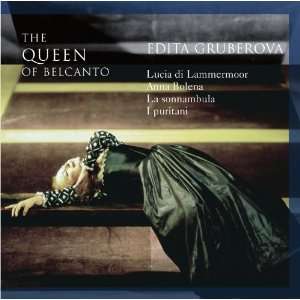|
Back
12/15/2012
«The Queen of Belcanto»
Gaetano Donizetti: Lucia di Lammermoor: “Il dolce suono”/”Ardon gl’incensi” & “Spargi d’amaro pianto” (“Mad Scene”) – Anna Bolena: “Come, innocente giovane” & “Ma poche omai rimangono”/”Non v’ha sguardo” (Cavatina)
Vincenzo Bellini: La sonnambula: “Ah! Se una volta sola”, “Ah! Non credea mirarti” & “Ah! Non giunge uman’ pensiero” – I puritani: “O rendetemi la speme”, “Torno il riso” & “Vien, diletto...!” (“Mad Scene”)
Edita Gruberová (Soprano), Failoni Chamber Orchestra of the Budapest Opera, Friedrich Haider (Conductor), Orchester des Ungarischen Rundfunks und Fernsehens, Delores Ziegler (Giovanna), Helene Schneidermann (Smeton), Elio Boncompagni (Conductor), Münchner Rundfunkorchester, Roberto Scandiuzzi (Rodolfo), José Bros (Elvino), Gloria Banditelli (Teresa), Marcello Viotti (Conductor), Ettore Kim (Riccardo), Francesco Ellero D’Artegna (Sir Giorgio), Fabio Luisi (Conductor)
Recording: Budapest State Opera (October 1998 [Lucia di Lammermoor]), Großer Saal des Wiener Konzerthauses (November/December 1994 [Anna Bolena]) & Herkulessaal, München (October 1993 [I puritani] & February 1998 [La sonnambula]) – 56’36
Nightingale #NC 190193-2 – Booklet in German and English

   
Those sopranos able who fall into the category of singing belcanto are in a hallmark league of their own. Edita Gruberová can stake claim to this profoundly difficult vocal style. Partnered with Nightingale, The Queen of Belcanto nicely summarizes Gruberová’s talents and technical abilities.
What better way to honor this distinct form of “beautiful singing” than to highlight poignant arias from selected operas by Donizetti and Bellini. Here we have wonderful selections from the well touted Lucia di Lammermoor, the tripartite Tudor trilogy Anna Bolena, and finally melodramatic moments from Bellini’s La sonnambula and I puritani.
Edita Gruberová is a voice of incredible proportions yielding weighted timbre and bubbly froth while encapsulated with a distinctly chirpy and shrill edge. No matter the challenge, this queen of belcanto steps up to the plate with assuredness, handling complex gyrations, fioratura technique and atmospheric high notes with the greatest of ease. Friedrich Haider moves along Lucia’s “Spargi d’amaro pianto” in brisk tempo while acquiescing to Gruberová. Gruverová’s legatos are long, breathless and sustained. She can easily control a note by beginning with pianissimo and then crescendo to mezzo forte.
In Anna Bolena’s “Cavatina” one will find Gruberová’s exemplary use of acciaccatura that rivals any other distinguished prima donna. The crowning chords in varying arias from La sonnambula and I puritani are powerfully momentous which at times are achieved by sweeping to the final high note.
Those who relish the embellished circuitry of early 19th century opera will undoubtedly enjoy listening to the radiance and meticulous artistry emanating from this Slovakian native. These choice pieces from live recordings are well captured. The orchestras, conductors and supplementary voices are splendid. Edita Gruberová is, indeed, one of those great queens of belcanto.
Christie Grimstad
|